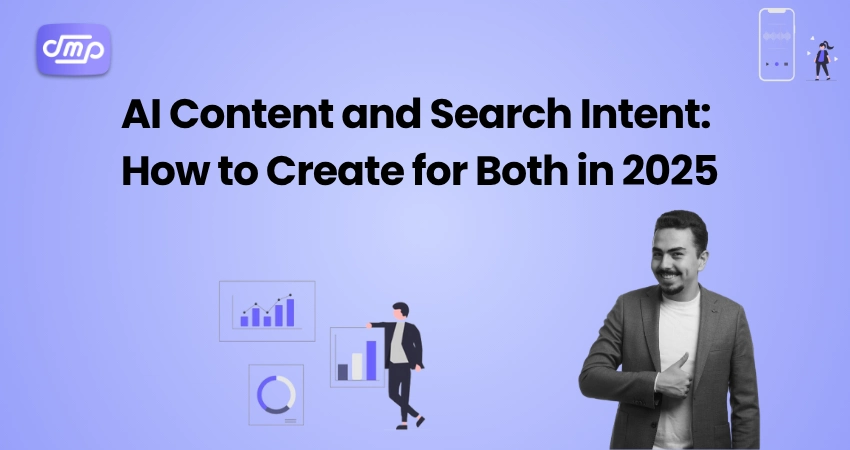
- June 9, 2025
- Digital Marketing, seo
- Search Engine Optimisation (SEO)
Table of Contents
Aligning content with user intent is crucial in today’s SEO and digital marketing world, especially as search engines like Google continue to prioritize relevancy, user experience, and overall experience. Whether you use AI to produce content or write it manually, failing to match the user’s purpose can lead to poor rankings, low engagement, and high bounce rates. Hence it is very essential to combine AI content and search intent.
Here's why matching content with user intent is critical:
- Improves search engine rankings: Google’s algorithm is intended to deliver the most relevant material based on what visitors are looking for, not just the terms they type. When your material responds to a user’s specific query (whether informational, navigational, transactional, or commercial), Google is more likely to rank it higher in search results. Intent-aligned content has a higher CTR, reduced bounce rates, and longer dwell time—all of which are excellent SEO signs.
- Improves User Experience: When users find exactly what they’re looking for on your page, they’re more inclined to remain, explore, and convert. Misaligned material irritates visitors and directs them to competitors. Matching search intent demonstrates to your audience that you understand their demands, which helps to develop trust and authority in your field.
- Increases engagement and conversions: Content that corresponds to the appropriate stage of the buyer’s journey (awareness, deliberation, or decision) directs consumers to take action. For example, Blogs, manuals, and explanatory films should be used to meet informational intent. Product pages, demos, and offers should all help to support transactional intent. When content aligns with the proper intent, it automatically fosters deeper engagement and higher conversion rates.
- Supports AI Content Strategy: With the rise of AI-generated content, intent alignment serves as an important regulatory tool. AI can generate large amounts of content quickly, but if it is not guided by a clear aim, the content can become generic or irrelevant. Feeding AI technologies with prompts based on user intent ensures that content has a true purpose and resonates with the intended audience.
- Reduces content waste: Producing content without understanding what users really want wastes time, energy, and money. When your content strategy is aligned with actual aim, each piece you create has a clear goal and target. This leads to more efficient content generation and a higher ROI.
- Future-Proof Your SEO Strategy: Search intent is central to how search engines are evolving. With increasing personalization, voice search, and AI integration in search algorithms, understanding and aligning with user intent will only become more important. Brands that master intent-driven content creation will be better positioned to adapt and thrive in the future.
Understanding Search Intent in 2025
As search engines get more sophisticated, understanding AI content and search intent is more important than ever, especially when developing AI content. By 2025, the way humans search and machines interpret those searches will have changed substantially. To remain relevant, marketers and content providers must look beyond keywords and deliver material that perfectly meets consumer expectations.
The Evolving Landscape of Search Intent
Search intent is the reason behind a user’s search query. Is the user wanting to learn something, make a purchase, compare items, or locate a particular website? In 2025, search engines such as Google will leverage AI-driven natural language processing (NLP), machine learning, and contextual awareness to better discern the underlying intent behind each query, rather than just the words used.
Voice search, visual search, and conversational AI (such as ChatGPT or Google’s Bard) have also changed the way queries are structured. Instead of short, keyword-heavy phrases, users frequently enter complete queries, natural sentences, or even emotional indications.
Types of Search Intent To Consider
When developing AI-generated or humanly authored content in 2025, it is critical to know the four main categories of search intent:
Informational Intent
Users are seeking information or answers.
Best content formats include blog entries, how-to tutorials, and explainer videos.
Navigational Intent
Users wish to reach a specific website or brand.
Example: “OpenAI content tools”
Best content formats include landing pages, branded content, and FAQs.
Transactional Intent
Users are prepared to make a purchase or complete an action.
Like this one: “Buy AI content generator subscription”
Best content types include product pages, reviews, and limited-time deals.
Commercial Investigation
Users compare products and services before making a decision.
Best content formats include comparison pieces, product reviews, and listicles.
How AI Content Can Align with Search Intent

In 2025, using AI to create content means more than just automating writing activities; it also means proactively directing AI technologies to address specific user goals. Here’s how to do it effectively:
- Prompt engineering: Create prompts with explicit intent in mind to guarantee that the AI generates relevant, intent-focused material.
- Data-driven insights: Use tools that assess user activity, search trends, and query semantics to inform content strategy. AI content should be personalized based on user profiles, geography, and previous interactions in order to better match intent.
- SERP analysis: Analyze the top-performing pages for your target keywords to determine what type of content meets user expectations.
The Rise of AI in Content Creation

Artificial intelligence has quickly evolved from a futuristic concept to a key component of modern content marketing. By 2025, the rise of AI content and search intent in content creation will be more than a fad; it will represent a fundamental transformation in how organizations, marketers, and creators approach digital communication.
AI-powered technologies have advanced from simple automation engines to sophisticated systems capable of creating high-quality blog posts, video scripts, ad copy, social media material, and even SEO-optimized articles. Natural language processing (NLP) models like as OpenAI’s GPT series, Google’s Gemini, and other large language models (LLMs) enable AI to better comprehend context, tone, and audience needs than ever before.
This change is especially significant when we consider the link between AI content and search intent. Previously, content development was generally focused on quantity—publishing more to capture more keywords. However, as search engines have advanced, comprehending the user’s purpose behind each query has become increasingly important. AI tools may now bridge that gap by studying trends, comprehending semantic search, and creating content that is relevant to what users desire.
For example, an AI tool can evaluate the search query “best AI tools for SEO in 2025” and determine that the user has a business investigative intent. Based on that information, the AI can create a comparison-style blog post that directly addresses the user’s requirements. This is a clear example of how the combination of AI content and search intent increases relevance, engagement, and conversions.
Furthermore, AI is not only improving content creation; it is changing roles. Writers and marketers are now strategists and editors, collaborating with AI to direct its output, add a human perspective, and ensure content is consistent with the brand voice and objectives. The end effect is shorter production timeframes, increased scalability, and, in many cases, better-performing content.
As AI advances, it will play an increasingly important role in predictive content, anticipating future requests and developing evergreen pieces that meet emerging intents. For brands, mastering the partnership of AI and human innovation is critical to remaining competitive in the digital landscape of 2025.
Challenges in Aligning AI Content with Search Intent
While AI tools have transformed digital marketing and content development, aligning AI content and search intent remains a significant hurdle. Despite the efficiency and scale that AI provides, ensuring that the generated content genuinely satisfies what people are looking for necessitates strategic control, human refinement, and ongoing adaptation.
- Misinterpretation of search intent: One of the most significant issues is that AI, even with strong natural language processing capabilities, can misinterpret the user’s intention. For example, the term “how to use AI in marketing” may imply instructional goal, but depending on the context, it could also indicate commercial or navigational intent. AI models may not always be able to distinguish these nuances unless they are guided by a well-trained human operator.
- Generic or surface-level output: AI-generated information frequently lacks the depth and context-specific insights that human specialists provide. While it can swiftly generate understandable and structured content, the content may be overly general, lacking the unique views or in-depth research required to satisfy complicated or specialized search intents.
- Inadequate keyword-intent mapping: Aligning AI content and search intent takes more than simply putting keywords into paragraphs. It entails determining the “why” behind a question and then creating material that successfully answers it. Although AI systems can generate keyword-rich material, without strong editorial supervision, the content may fall short of meeting genuine user demands, resulting in increased bounce rates and reduced engagement.
- Lack of Contextual Awareness: AI frequently functions using the data on which it was educated. It may not always accurately reflect current trends, cultural context, or industrial knowledge. When dealing with time-sensitive or specialist issues, this constraint can prohibit AI material from being relevant to current user intent.
- Difficulty balancing SEO and user experience: AI material might be over-optimized for search engines by packing keywords, repeating phrases, or providing unrelated headings. This degrades the user experience. In 2025, when Google and other search engines favor helpful material, striking a balance between SEO tactics and true intent-matching will be more important than ever.
- Overreliance on AI without human review: Another difficulty is the tendency to completely automate content generation without human oversight. Even the most advanced AI cannot replicate the complexity, sensitivity, and brand-specific tone that humans provide. Without human input, AI-generated content may be tone-deaf or misaligned with user expectations, failing to meet true search intent.
- The Evolving Nature of Search Behavior: Search intent changes throughout time, depending on trends, devices, platforms, and user expectations. AI tools must be regularly upgraded to keep up with these advances. Failure to do so means that AI-generated material may fast become obsolete or inconsistent with current search habits.
Conclusion
As we approach 2025, the integration of AI content and search intent becomes increasingly important for successful digital marketing. While AI has substantially increased the speed and scale of content creation, true efficacy comes from aligning this material with what users are actually looking for.
Understanding the subtleties of search intent—whether informational, navigational, commercial, or transactional—is critical to creating content that ranks and resonates. AI can assist with content creation, but human insight, smart keyword mapping, and a thorough understanding of audience behavior ensure that the content is meaningful, relevant, and valuable.
Finally, the future belongs to those who can combine the strength of AI content and search intent with a strong emphasis on consumer demands. Brands that achieve this balance will be better positioned to promote engagement, trust, and long-term success in the competitive digital market.











